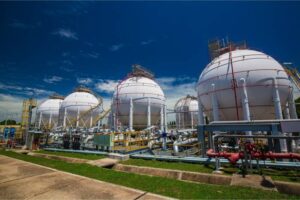Production Holds Steady Amid Falling Rig Counts: A Closer Look at the Natural Gas Market
As we navigate through the ever-evolving landscape of the natural gas market, one undeniable trend emerges: production remains unwavering, even as the number of active rigs in the U.S. dwindles. Last week saw a reduction in the natural gas rig count, down to just 96 after a decrease of seven rigs. Despite this drop, output is defying expectations, with lower-48 dry gas production averaging an impressive 106.4 billion cubic feet per day (Bcf/d) on Friday—an increase of over 4% compared to the same period last year.
This robust production comes at a time when demand is softening. Industrial and residential usage levels are subdued, and power burn rates, while stable, have yet to undergo the usual seasonal ramp-up we anticipate as temperatures begin to warm. The current state of the market paints a picture of excess supply, particularly with the absence of weather-induced demand spikes that typically invigorate the sector.
Did the Latest Storage Report Shift Market Expectations?
In a notable development, the recent report from the Energy Information Administration (EIA) indicated a remarkable 29 Bcf injection into storage for the week ending March 28. This figure stands in stark contrast to the five-year average draw for the same period. While it’s worth noting that overall inventories remain 21.5% lower than last year and 4.3% below the five-year average, the significant early injection indicates that mild weather and abundant supply are enabling early stockpiling, shifting market dynamics sooner than anticipated.
This situation has cultivated a near-term bearish sentiment among traders. The market is bracing for the potential of larger-than-expected builds in the forthcoming weeks, raising questions about how this might affect pricing strategies and investment decisions.
Can LNG Exports Offset Domestic Weakness?
While the domestic landscape appears challenging, one glimmer of hope remains: LNG (liquefied natural gas) exports. Flows to U.S. export terminals have held steady at approximately 15.5 Bcf/d. Although there was a slight week-over-week reduction, this continuation in exports supports baseline demand—offering a buffer to the overwhelming supply currently on hand.
On a longer-term trajectory, recent policy shifts, including President Trump’s decision to eliminate restrictions on LNG export project approvals, are reviving a significant backlog of infrastructure proposals. If a portion of these projects comes to fruition, we could see a substantial increase in export capacity, which would be instrumental in managing domestic oversupply. However, it’s important to recognize that, at this juncture, the narrative surrounding exports serves more as a long-term factor in pricing rather than a remedy for the current disparities in supply and demand.
Market Forecast: Bearish Near Term on Demand and Supply Imbalance
Looking ahead, the outlook for natural gas in the short term is decidedly bearish. Key factors contributing to this sentiment include the reduced weather-driven demand, strong production levels, and the early-season storage builds, all of which are steering the market toward an oversupply scenario. Unless an unexpected cold snap occurs or we witness an uptick in LNG demand, natural gas prices are likely to remain under pressure in the immediate future.
In the world of investing, information is power, and understanding the underlying trends in the natural gas market can position you for greater success. Stay tuned to Extreme Investor Network for further insights, as we continue to analyze the forces shaping the markets and provide you with the tools needed to navigate this complex environment successfully.

